Advertising your real estate business and services on Facebook is an effective way to target your audience, capture leads, and build your brand. Facebook provides extensive options for targeting a highly specific audience in a variety of ways so you can efficiently build an authoritative reputation and find new leads. We’ll walk you through the process of creating powerful Facebook ads for real estate agents—from selecting objectives to identifying your target audience and converting leads.
If you want professional assistance creating Facebook real estate ads, use the built-in Facebook tool from Real Geeks. In addition to creating Facebook ads, Real Geeks tracks ad performance for cost-per-click (CPC), likes, shares, and more using tracking pixels. Your leads will funnel into the Real Geeks CRM (customer relationship management) tool, where you can follow up with easy lead nurturing and conversion strategies to grow your business.
1. Create Your Facebook Ads Manager Account
The first step of learning how to run Facebook ads for real estate is finding the “Ads Manager” in the drop-down menu and setting up your ad account. You may need to create a real estate business page if you don’t already have one. Otherwise, Facebook will lead you through the process of connecting your business account to the Meta ads platform.
The steps to create a Facebook page include the following:
- Choosing a page name and category
- Adding a cover photo and profile picture of your realtor headshot
- Adding your real estate bio in the “About” section
- Adding an action button
- Choosing page tabs
- Inviting friends and family to like your page
- Publishing content
Start with a well-optimized profile to get the best results from your realtor Facebook ads. Check out our full guide on How to Set Up a Realtor Facebook Page in 10 Steps to get step-by-step directions to set up your page, optimize it, and use it to generate leads.
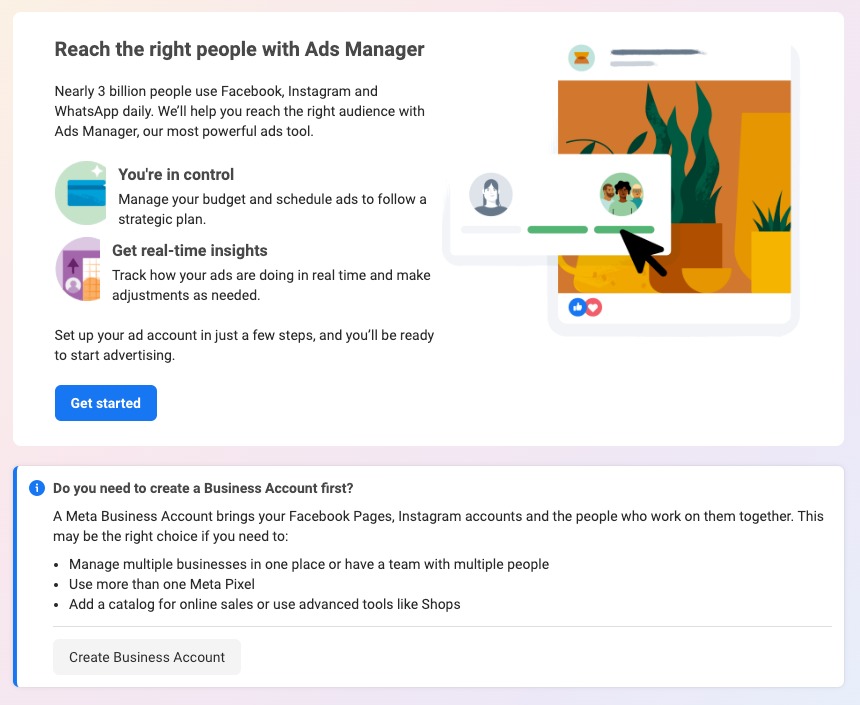
Facebook Ads Manager set up page (Source: Facebook)
2. Select Your Campaign Objective
Once you click “Create ad campaign,” your first action will be choosing a campaign objective. The objectives are based on the six stages of the sales cycle: awareness, traffic, engagement, leads, app promotion, and sales. Each objective allows you to target visitors in different stages of the sales process, like those who are contemplating the purchase of a property within the next year or those who are ready to employ the services of a real estate professional within the next few weeks.
Here are a few examples of strategies to use for potential leads in each stage of the cycle:
Campaign Objective | Purpose | Ideal Result |
|---|---|---|
Awareness | Show up to future buyers or sellers to build a familiar brand. Leads in the awareness stage aren’t active or may simply be toying with the idea of buying or selling their property. Introduce your brand and services with videos or images. |
|
Traffic | Increase traffic to your preferred online destination. Send people to a specific site, such as your real estate website, Facebook page, or app. |
|
Engagement | Find people more likely to interact with your company online, send a message, or take the desired actions on your ad or Page. For instance, you could use Messenger to encourage people considering your products or services to start conversations. |
|
Leads | Messages, phone calls, and sign-ups can all be used to capture and generate leads for your real estate company or brand. This objective will drive traffic directly to a platform to capture their contact information. |
|
App promotion | Encourage users of mobile devices to install or perform a specific action within your app. |
|
Sales | This phase of business aims to find people who are likely to convert into clients more quickly. You can target other activities, like having them add something to their cart. |
|
In order to create real estate Facebook ads that work, you must strategically choose your objective and target clients in that particular stage of the sales cycle. For instance, if your real estate business is brand-new or has been renamed, awareness may help potential clients become more familiar with your real estate business.
3. Create & Name Your Campaign
With a clear objective, the next step is to name your campaign. This name will only be for internal reference and won’t be visible to users. You will also be able to select whether or not this campaign will include a single advertisement or an ad set with multiple ad variations under “Advantage Campaign Budget.”
The next prompts will ask you to add categories, and real estate Facebook ads will fall under the “Housing” category. This is important because Facebook ads for real estate agents must follow specific targeting parameters to prevent discrimination. For instance, you will be unable to target by age, gender, or ZIP code, as this could be considered a violation of Fair Housing Regulations.
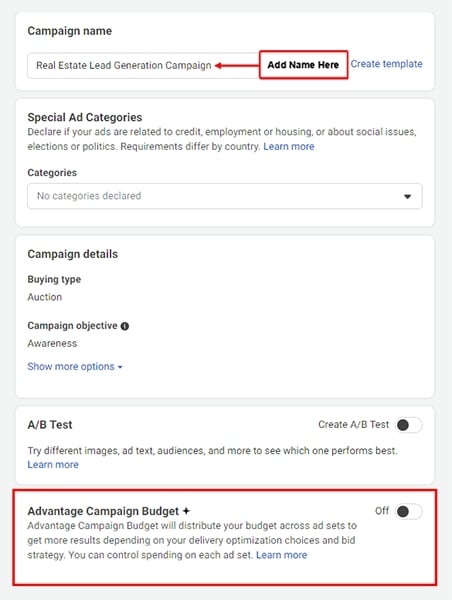
Facebook Ad Manager Campaign section (Source: Facebook)
Even with more limitations, the targeting options provided by Facebook are still extremely effective. Other parameters you’ll be able to set to target your ad include location radius and interests like hobbies, businesses, and entertainment, as well as where ads will be placed and displayed.
4. Set a Posting Schedule & Budget
The next screen will ask you to input the start and end dates of your realtor Facebook ad and your maximum daily budget. The Facebook algorithm will handle the specifics of how often your ads are shown and the final cost. Your daily budget is not how much you will actually spend, because advertising is based on a bidding system. Learn more about how it works in our full guide to Facebook ads costs.
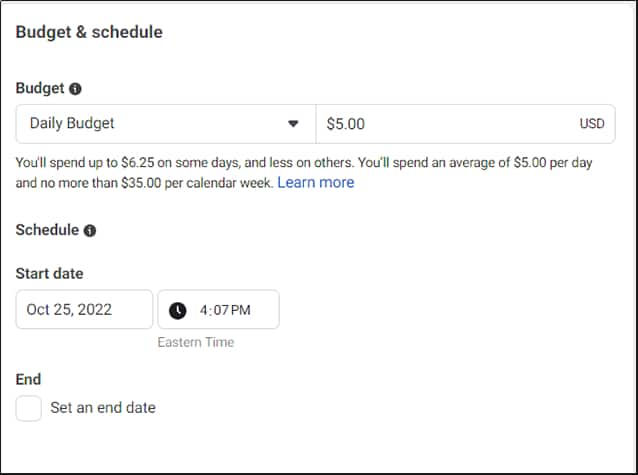
Facebook ad posting budget and schedule (Source: Facebook)
According to a study by Belle Strategies, the average Facebook cost per real estate lead is around $9.76. However, depending on your lead generation platform and the clicks you get on your Facebook advertising campaigns, it can cost anywhere from $15 to $75 per lead. This is an excellent return on investment (ROI) compared to other marketing strategies and comparable to using real estate Google ads.
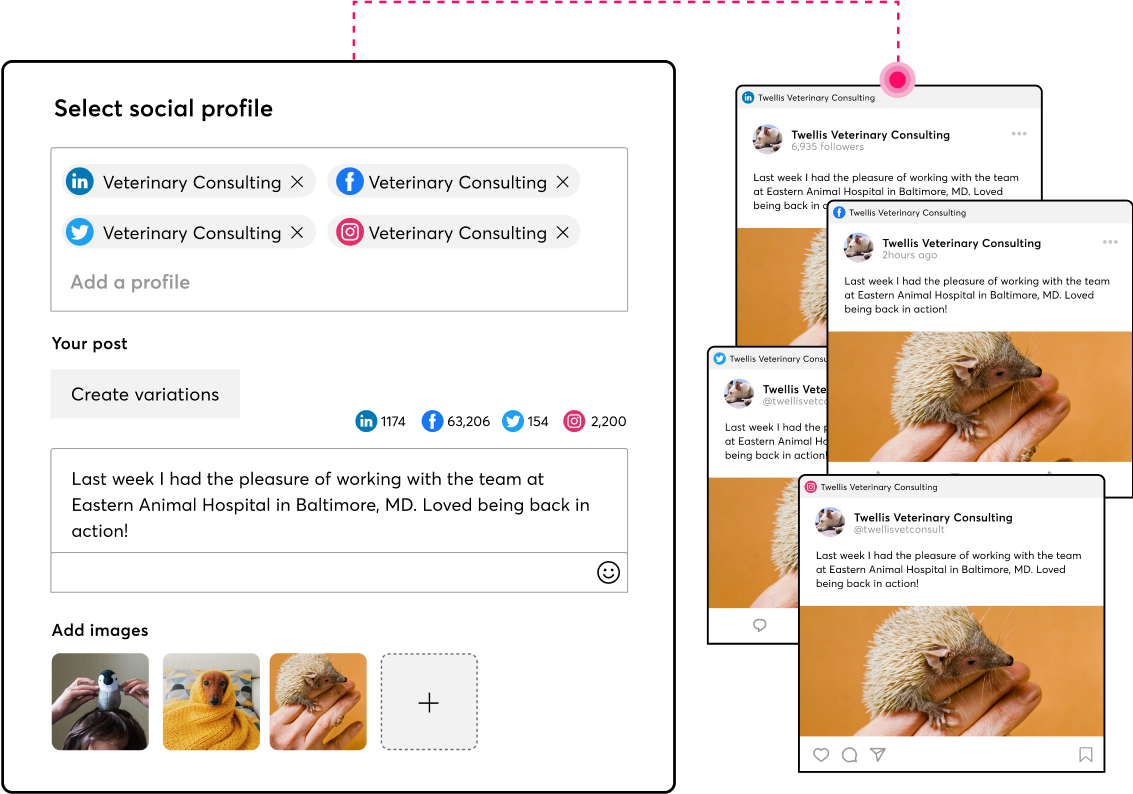
Social media post scheduler (Source: Constant Contact)
To optimize your ad campaigns for the highest return on investment (ROI) without spending hours, days, or weeks figuring out the technical details, check out Constant Contact. It provides intuitive publishing and scheduling tools to create and manage your real estate Facebook posts. Constant Contact helps strengthen your social media strategy and nurture your leads and clients through email and text message marketing.
5. Identify Your Target Audience
Targeting is crucial in becoming successful in real estate, and is also one of the most important steps in learning how to create Facebook ads for real estate. Start by putting yourself in the mindset of your target audience. Identify the interests of your audience, like real estate, furniture, business, and industry. Think backward and profile your audience in order to create ads that appeal to the right people.

Facebook ad target audience section (Source: Facebook)
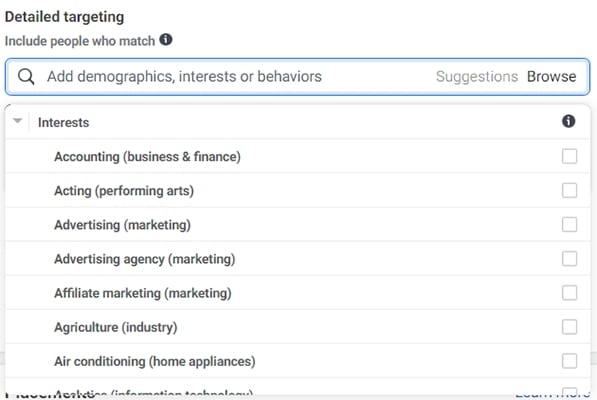
Detailed targeting options (Source: Facebook)
For example, if you wanted real estate Facebook ad ideas for buyers and sellers in Edmond, Oklahoma, it’s important to know that the median list price is $412,900. It has the most highly rated public schools in the state, and there are many community and family-friendly activities and amenities all year round. It is also located near multiple well-known colleges and universities. With this information, you could potentially target couples, families, or young professionals. Keep in mind that the Fair Housing laws prohibit targeting certain demographics, behaviors, and interests due to discrimination, which will limit your options for certain details.
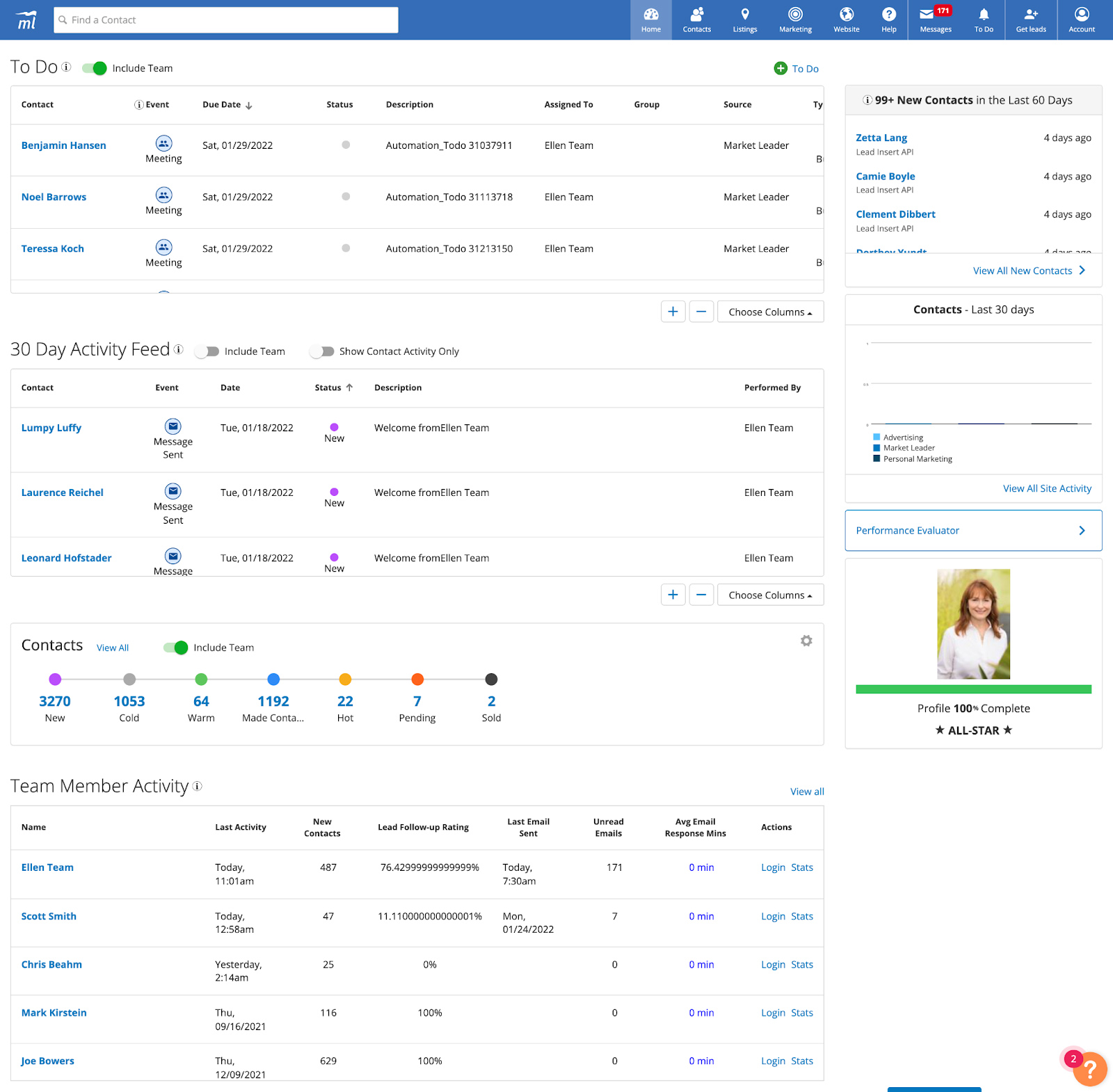
Market Leader agent dashboard (Source: Market Leader)
As you create your targeting plan for your audience, you should also consider the best way to nurture these leads to become clients. You can be prepared to manage and nurture leads from your real estate Facebook ads by having a real estate CRM and an automated follow-up system with a tool like Market Leader. This platform not only helps manage your Facebook ads, but also funnels the leads into your CRM and sends automated emails and even direct mail.
6. Select Ad Placement
There are a few elements of Facebook advertising for real estate agents that may be surprising if you’ve never run ad campaigns before. For example, you might envision your ads showing up in a particular spot, like your audience’s home feeds, but there are a variety of placement options. Most Facebook ads for real estate agents are placed in one of the four primary spots; Facebook, Instagram, Facebook Messenger, and Audience Network.
The additional placement options include:
- Facebook News Feed
- Instagram Feeds
- Instagram Stories and Reels
- Facebook and Instagram In-Stream Videos
- Search Results
- Messages
- In-Article
- Web Banners
- Apps and Sites
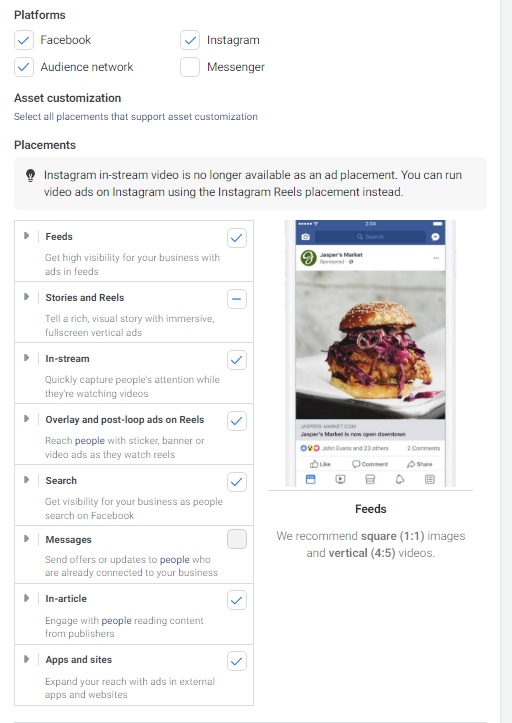
Manual Facebook ad placement options (Source: Facebook)
You can allow Facebook to automatically place your real estate ads on various channels or manually specify where and how you want your ad to be shown to users. To decide where to place your realtor Facebook ad, refer back to the profile you created for your target clients. Consider where your clients are spending more of their time. If you think your audience is more likely to use Instagram than Facebook, then concentrate most of your advertising on that platform.
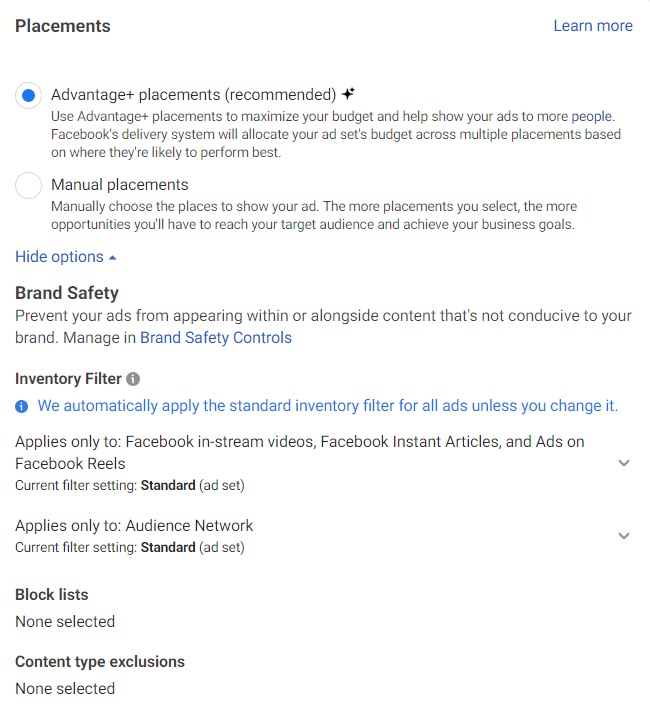
Automatic Facebook ad placement selection options (Source: Facebook)
7. Create Your Ad
Finally, the last step of creating real estate ads on Facebook is to design and create them. This is the actual product your audience will see, including creative details like images, video, and ad copy. The ad creation process will have a direct impact on the overall success of the ad, so take the time to develop an ad that is visually appealing and clearly communicates to your target audience.
Depending on your objectives and placements, Facebook will generate the proper ad formats. The most common formats for Facebook ads for realtors are single-image ads, video ads, and carousel posts. As you input your headline, photo or video, and description, Facebook will show your ad preview.
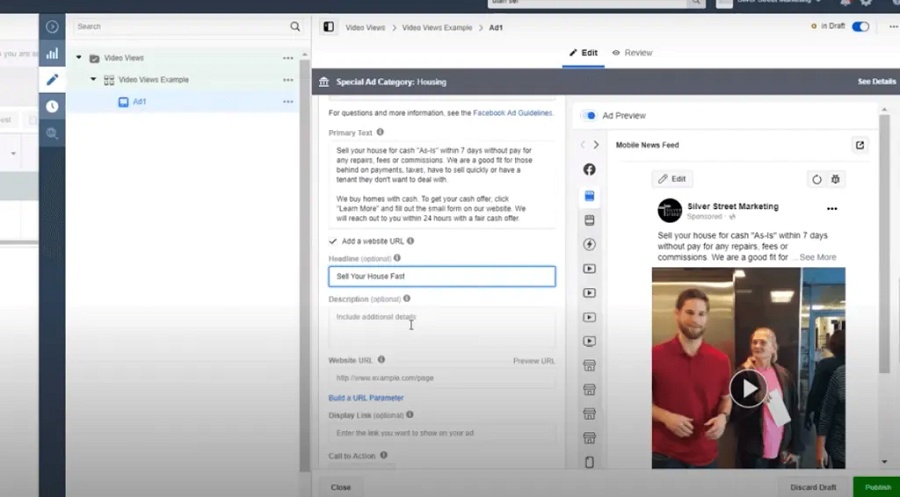
Facebook ad creator (Source: Carrot)
8. Integrate Your CRM & Convert Leads
Before you hit publish, creating a plan to manage your new flow of Facebook real estate leads is important. Without a thorough plan to collect, track, and nurture these leads, you’ll inevitably miss out on valuable clients and income. It’s crucial to have customer relationship management (CRM) software that automates communication, reminds you when you need to complete manual tasks or personally reach out to leads, and even helps your team, brokerage, or assistants to work together more efficiently.
Consider choosing a CRM that has a built-in Facebook integration to seamlessly incorporate your Facebook leads into your sales funnel.
A few of the best real estate CRMs include:
CRM Software | ||||
|---|---|---|---|---|
Best For | Professionals wanting a real estate-focused CRM built to integrate leads from third parties | Agents, teams, and brokers wanting to automate tasks and project management | Real estate professionals who need a robust CRM with advanced email marketing tools | Agents or teams wanting an all-in-one real estate CRM with robust automation tools |
Key Features |
|
|
|
|
Starting Price | $25 per month | $25 per user, per month | Free; paid plans start at $20 per month | $69 per user, per month |
Learn More |
Realtor Facebook Ad Examples & Why They Work
Many agents mistakenly believe that listings are the only way to generate real estate leads with ads. However, many of the best Facebook ads for realtors have unique content and attract leads in a variety of different ways. For example, you can advertise your market reports, blog content, a free consultation, or an event. To get even more ideas, check out these sample Facebook ads for real estate:
Creating real estate newsletters is a relatively common marketing strategy for agents to build a strong reputation, support clients, and increase their reach. Most agents who create newsletters distribute them by email or through direct mail, but advertising is another great way to leverage this content. For example, Rose Rogers Real Estate used a simple graphic to catch their audience’s attention. You could also provide a link to a more detailed report, where you capture each lead’s contact information.
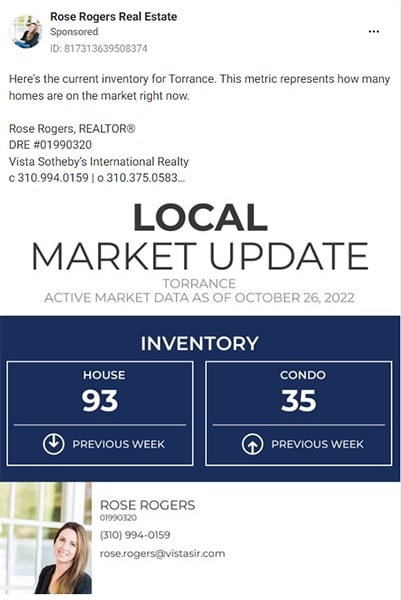
Real estate market update Facebook ad (Source: Facebook)
Although the messaging of this type of real estate ad is somewhat general, these ads help build brand recognition and trust. This wouldn’t be the right choice to generate buyer leads who are ready for a transaction, but it is ideal for growing your real estate brand and targeting leads with a long-term plan to buy or sell a house.
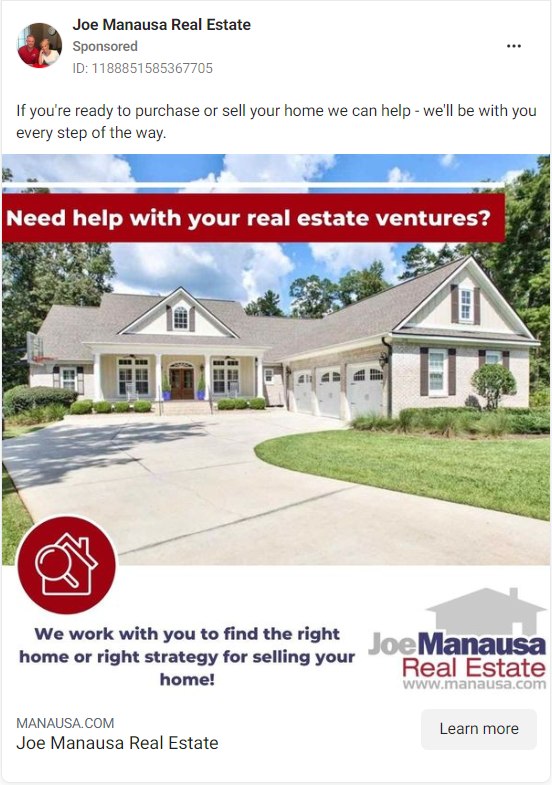
Awareness Facebook ads for real estate agents (Source: Facebook)
This Facebook ad is simple and targets potential buyer and seller leads in a specific geographical location. This may seem like a large area to target, but you could use this real estate Facebook ad template to target clients in a small area or even in small neighborhoods. This can build your reputation as the go-to agent for specific locations.
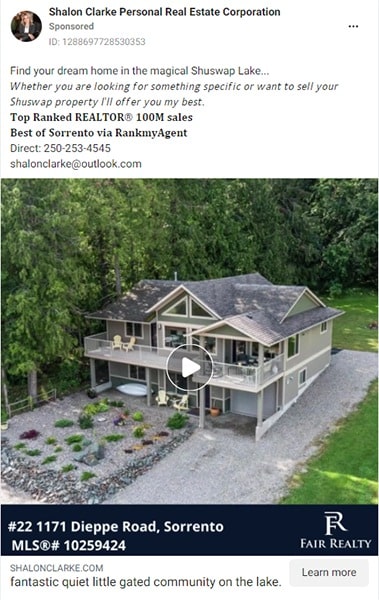
Geographic real estate Facebook ad example (Source: Facebook)
Real estate listings are arguably the most common type of Facebook ads for real estate agents. Advertising a listing helps increase its exposure to a local audience, drive traffic to a landing page or website with more details, and find leads looking to purchase within the next six months. You can increase the appeal of these ads by offering access to an off-market listing or creating a virtual tour.
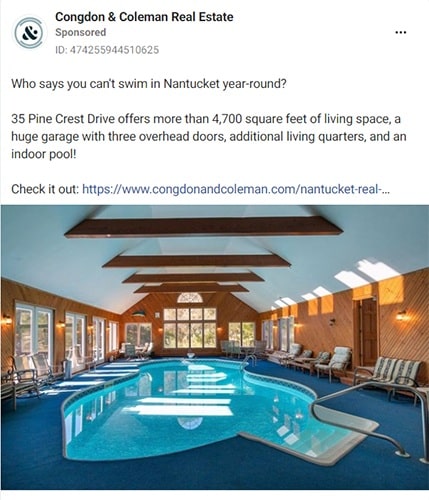
Real estate listing advertisement in Nantucket (Source: Facebook)

Real estate listing advertisement in California (Source: Facebook)
This ad clearly targets seller leads who are in a difficult situation and don’t have the flexibility to follow the typical sale process. These leads are frequently targeted by real estate investors, but they can also be a great source of leads for agents who want to develop a reputation in this niche.
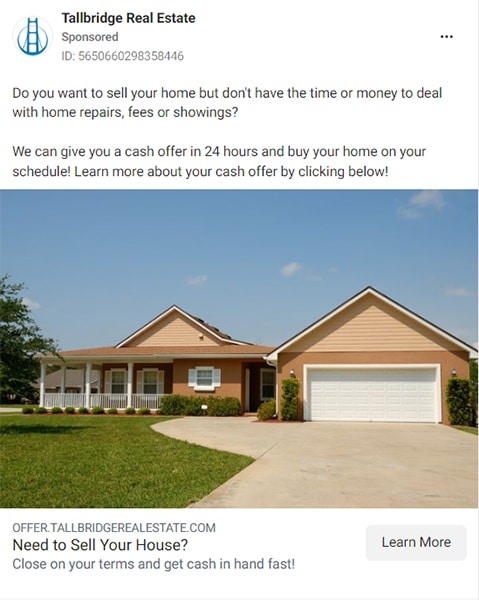
Facebook ad for distressed home sellers (Source: Facebook)
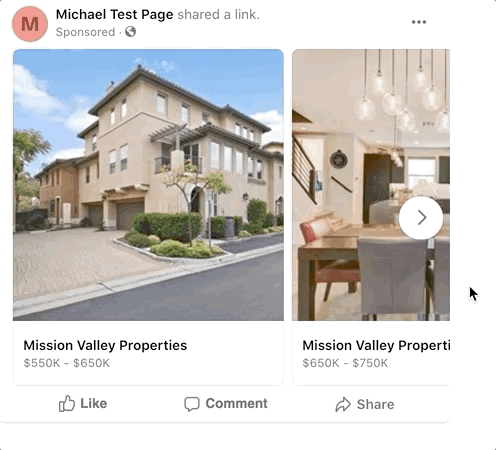
Real Geeks Facebook ad example (Source: Real Geeks)
If the idea of building and optimizing your real estate Facebook ads is overwhelming, there are tools to streamline and simplify the process. For example, Real Geeks provides an easy-to-use platform specifically to help real estate professionals design engaging Facebook ads for properties, website links, and more. The platform also includes a robust CRM, customizable website, and email marketing tools and templates to automatically nurture leads and get the most out of your ads.
Frequently Asked Questions (FAQs)
Yes. Facebook ads can be incredibly effective for real estate businesses when used correctly and strategically. For real estate agents, Facebook ads provide a way to reach a wide and highly targeted audience with a flexible budget. However, not all Facebook ads are equal, and your success depends on your ability to strategize, create, and analyze your ad’s performance.
To optimize your real estate Facebook ad, start by defining a clear objective for your campaign. This could include lead generation, brand visibility, or website traffic. Then, specify your target audience and use Facebook’s built-in tools to target leads in your target location and in the real estate sales cycle. Finally, design your ad with high-quality visuals and strategic language to capture the attention of your audience and generate clicks and leads.
The cost of Facebook ads for real estate agents varies widely depending on multiple factors, like location, targeting options, competition, and ad quality. However, the average cost-per-click (CPC) for real estate Facebook ads is 45 cents, and the average cost-per-mile (CPM, or cost per one thousand impressions) is $12.22.
Bottom Line
Facebook ads for real estate agents can be undeniably powerful and surprisingly affordable compared to other advertising channels. Even though they may seem intimidating, following these steps will help you learn how to create real estate ads on Facebook that multiply your reach and generate more quality leads in less time.